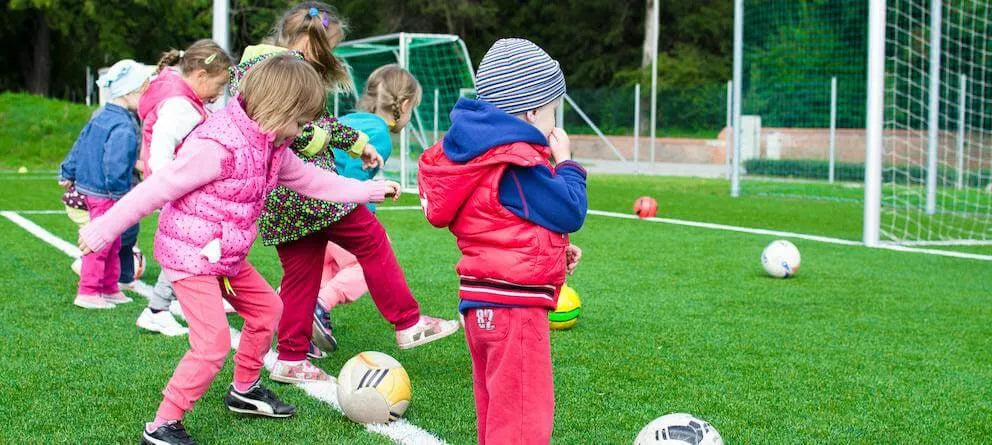Figuring out what soccer ball size to purchase your child as a parent can be challenging. You don’t always know which diameter is best, or how old your kid should be before you buy.
Fortunately, this guide will help. I’ve listed the various ball size recommendations by age so you know which to pick for younger players’ skill development. Usually, you’d start with the smallest balls for the youngest children and work up from there.
How Do I Know What Size Soccer Ball to Get?

Figuring out what size ball to get for your child is fairly easy once you understand how the system works. U.S. Youth Soccer and FIFA both provide size recommendations you can follow as a parent.
Sizes come numbered from one to five. Smaller balls are meant for younger players with smaller feet, keeping the ratio of foot size to ball size reasonably constant as they grow up. Below, we look at specific sizes by age group and how they vary.
Soccer Ball Sizes by Age Group

Here’s how soccer ball sizes correspond to children’s age groups:
Toddlers (Ages 2-4)
Recommended Size: Size 1
Toddlers aged 2 to 4 usually use size 1 soccer balls. These give young children a size and weight that’s suitable for their small feet so they don’t feel like they are kicking a beach ball. Balls in this category measure 45-51 cm in circumference and weigh around 205 grams.
Young Kids (Ages 3-5)
Recommended Size: Size 2
Young kids aged 3 to 5 usually opt for size 2 balls. These are slightly larger reflecting the children’s increased foot size and leg strength, providing them with plenty of striking surface for passing and drills. These balls are 52-56 cm and weigh between 210 and 280 grams.
Kids (Ages 5-8)
Recommended Size: Size 3
Slightly older children of elementary school age should use size 3 soccer balls. These are substantially heavier and encourage them to get used to the weightiness of full-size balls on the pitch, particularly when learning body control. These measure 58-60 cm in circumference and weigh 300 to 320 grams.
Older Kids (Ages 8-12)
Recommended Size: Size 4
Those approaching high school age usually use size 4 soccer balls, which are nearly the same size as professional balls. These are essentially a “finishing school” for kids who’ve been practicing soccer all their lives, measuring 63-66 cm in circumference and weighing 360 to 390 grams.
Teenagers (Ages 12+)
Recommended Size: Size 5
Size 5 soccer balls are the largest and used by players aged 12 and up. By the teenage years, this ball should be standard, helping up-and-coming players develop the muscle memory they need to play at the club level or higher. These balls weigh 410 to 450 grams.
Soccer Ball Circumferences
The following chart summarized ball circumferences and the age children should be playing soccer with each size:
| Size | Circumference | Age Range |
|---|---|---|
| Size 1 | 18–20 inches (46–51 cm) | Under 4 years |
| Size 2 | 20–22 inches (51–56 cm) | Ages 3–5 |
| Size 3 | 23–24 inches (58–61 cm) | Ages 5–8 |
| Size 4 | 25–26 inches (63.5–66 cm) | Ages 8–12 |
| Size 5 | 27–28 inches (68–70 cm) | Ages 12 and older |
How to Buy the Right Soccer Ball
Even knowing these facts, choosing the right soccer ball can still be tricky. A ball might say “size 2” on the side, but that doesn’t guarantee quality.
Here’s my checklist for how to choose the right ball for your child:
- Match the ball size to your child’s age - Check the circumference is suitable for your kid. The wrong size could hamper skill development in the future.
- Check the ball’s material for durability and softness - A high-quality ball should feel firm and smooth. If the ball feels plasticy, it may not offer the longevity you want.
- Choose between indoor and outdoor-specific designs - The feel and weight of the ball will differ depending on playing environments, with outdoor balls being heavier to counteract wind.
- Look for official size and weight labeling - High-quality brands should include this information on the size, usually near the valve.
- Avoid overly cheap balls that lose shape quickly - If products look compressed or deform easily, pick another brand.
- Confirm the inflation level before testing - You can use a pressure gauge inserted into the valve for this. The ideal pressure for a football is 1.1 bar or 8,7 to 15.9 PSI.
-
Consider a training ball if it’s for regular backyard use - Training balls are the right size for growing children, and are a useful addition to the backyard as they grow.
Soccer Ball Sizes FAQ’s
If you still have questions about soccer ball sizes, this section will give you answers. Here’s everything you need to know:
1. How much does a size 5 soccer ball weigh?
Size 5 soccer balls are the heaviest of all and weigh between 410 and 450 grams depending on the manufacturer and material used. These balls have some heft to them, but are standard for adult games and club meets, making them ideal for budding teenage professionals.
2. What size ball does FIFA use?
FIFA uses size 5 soccer balls for professional matches. It also recommends this size for children over 12 due to their growing feet and the need to get them used to professional-grade balls. Smaller balls are okay for drills and early training, but eventually, kids should move onto the larger sizes.
3. Is there a big difference between size 4 and 5 soccer balls?
Viewed face on, the difference between size 4 and size 5 balls seems small. However, the volume and weight of these balls varies by around 25%, which is considerable. Size 4 balls are between 350 and 390 grams and a full 3 to 5 cm less in circumference.




